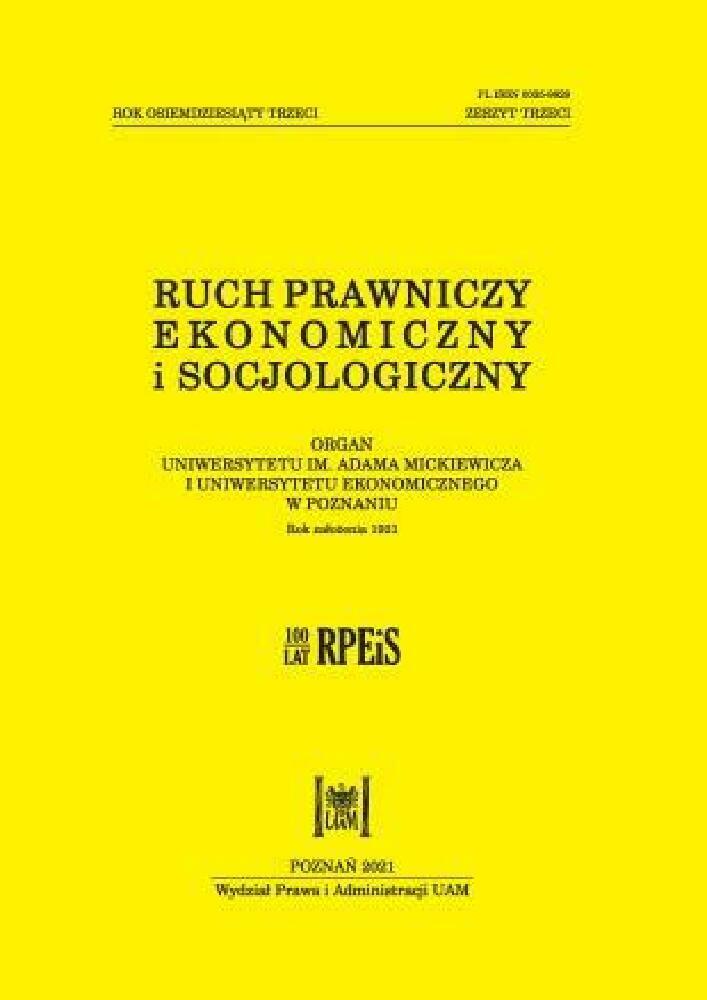Abstract
In terms of the welfare of both human and animal populations, in Western countries animal homelessness is a serious social challenge. Increasing emphasis is placed on controlling the size of the population of animals, particularly stray and feral ones. Three methods of reducing homelessness are most often indicated: education of animal owners, spaying/ neutering animals, and their permanent identification. In Poland the prevention of animal homelessness is a responsibility of the local municipalities. Although legislation allows municipalities to promote spaying/ neutering animals that have owners, there are not many municipalities which decide to dedicate a budget for such activities. This is evaluated negatively by the highest Polish authorities and controlling institutions. In this text we present empirical research on introducing programs that encourage the owners of animals to conduct spaying/castrating procedures. We also identify reasons why municipalities are not willing to designate resources for this purpose.
References
Amos, H. (2018). Is Russia killing stray dogs ahead of the World Cup? <https://www.theguardian.com/cities/2018/may/29/russia-stray-dogs-world-cup-cull-sochi-yekaterinburg> [dostęp: 24.04.2019].
Baś, M., Cywińska, A. (2006). Wczesna kastracja i sterylizacja psów i kotów. Życie Weterynaryjne 81(4): 246–250.
Centonze, L.A., Levy, J.K. (2002). Characteristics of free-roaming cats and their caretakers. Journal of the American Veterinary Medical Association 220(11): 1627–1633. doi: 10.2460/javma.2002.220.1627
Destoumieux-Garzón, D. et al. (2018). The one health concept: 10 years old and a long road ahead. Frontiers in Veterinary Science 5. doi: 10.3389/fvets.2018.00014
Jarzębowska, G. (2018). Follow the rat: from necropolitics to a theory of interspecies cohabitation. Journal for Critical Animal Studies 15(3): 4–25.
Krajowa Rada Lekarsko-Weterynaryjna (2018). Stanowisko Krajowej Rady Lekarsko-Weterynaryjnej z 19 grudnia 2017 r. w sprawie zabiegów operacyjnych wykonywanych masowo u psów i kotów poza siedzibami zakładów leczniczych dla zwierząt. Życie Weterynaryjne 93(2): 74.
Lisowski, A. (2018). Prywatna opinia na temat izbowej informacji o świadczeniu usług poza siedzibą zakładu leczniczego dla zwierząt. Życie Weterynaryjne 93(2): 84–86.
Lopez Negrete Communications (2010). Cesar Millan Spay and Neuter PSA – ENG. <https://www.youtube.com/watch?v=RmmZ_XOHqCA> [dostęp: 24.04.2019].
Mendes-de-Almeida, F., Remy, G.L., Gershony, L.C. et al. (2011). Reduction of feral cat (Felis catus Linnaeus 1758) colony size following hysterectomy of adult female cats. Journal of Feline Medicine and Surgery: 436–440.
NIK (2012). Raport: Wykonywanie zadań gmin dotyczących ochrony zwierząt. NIK (2016). Raport „Zapobieganie bezdomności zwierząt”.
Painted Dog Conservation. (2019). PDC Newsletter First Quarter 2019. <https://mailchi.mp/0cd5d56c7b2f/pdc-newsletter-first-quarter-2019?e=fd54257194> [dostęp: 30.01.2019].
PFRON (2019). Komunikat w sprawie przeciętnego wynagrodzenia. <http://www.e-pfron.pl/index.php/komunikaty/89-przecietne-wynagrodzenie-1#> [dostęp: 24.04.2019].
Phillips, S.C., Hedge, Z., Peralta, J.M. (2018). The role of private practitioners in reducing numbers of homeless dogs and cats and shelter euthanasia rates. Journal of the American Veterinary Medical Association 253(4): 404–408. doi: 10.2460/javma.253.4.404
Plesińska, O., Włosowicz, M. (2018). Kto pocieszy kaukaskie psy? Non-fiction. Nieregularnik reporterski. Zwierzę 4: 139–151.
Pollard-Post, W. (2017). ‘Fixing’ Animal Homelessness the Right Way. <https://www.peta.org/blog/fixing-animal-homelessness-right-way/> [dostęp: 24.04.2019].
Powell, M. (2015). Davis, M., End your stray dog cull, UK tells Romania: diplomats step up pressure after 300,000 animals killed in crackdown. <https://www.dailymail.co.uk/news/article-3132979/End-stray-dog-cull-UK-tells-Romania-Diplomats-pressure-300-000-animals-killed-crack-down.html> [dostęp: 30.01.2019].
Pręgowski, M.P., Włodarczyk, J. (2016). Researching the human-canine relationship in democratic Poland, [w:] M. P. Pręgowski, J. Włodarczyk (eds.), Free Market Dogs: The Human-Canine Bond in Post-Communist Poland. West Lafayette. West Lafayette: 1–35.
Przybek, A. (2017). Wiosenna akcja sterylizacji i kastracji zwierząt. <https://wpolityce.pl/blogi/398091-wiosenna-akcja-sterylizacji-i-kastracji-zwierzat> [dostęp: 24.04.2019].
Singer, P. (2018). Wyzwolenie zwierząt. Warszawa.
Skorupski, M. (2017). Zapobieganie bezdomności zwierząt. Ustalenia pokontrolne NIK, [w:] Kontrola Państwowa 2017/1. Warszawa.
Spain, C.V., Scarlett, J.M., Houpt, K.A. (2004). Long-term risks and benefits of early-age gonadectomy in dogs. Journal of the American Veterinary Medical Association 224(3): 380–387. doi:10.2460/javma.2004.224.380
Veblen, T. (2008). Teoria klasy próżniaczej. Tłum. J. Frentzel-Zagórska. Warszawa.
Wysocka-Andrusiewicz, J. (2019). O etycznym wymiarze ingerowania w seksualność pozaludzkich podopiecznych, [w:] H. Mamzer, A. Żok (red.), Bezpieczne czy zniewolone? Szkice o zwierzętach. Bydgoszcz: 249–277.
License
Copyright (c) 2021 WPiA UAM

This work is licensed under a Creative Commons Attribution-NonCommercial-NoDerivatives 4.0 International License.





